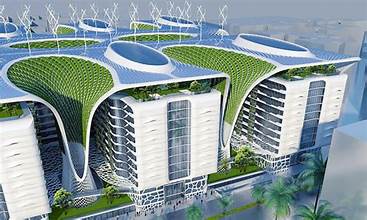Introduction: In an era marked by environmental consciousness and resource scarcity, the construction industry stands at a crossroads. With climate change accelerating and natural resources depleting, the imperative for sustainable construction practices has never been more pressing. Fortunately, the industry is witnessing a transformative shift towards innovative technologies and trends that promise to redefine the way we build. In this article, we delve into the future of sustainable construction, exploring emerging trends and cutting-edge technologies poised to shape the built environment of tomorrow.

- Green Building Materials: The cornerstone of sustainable construction lies in the materials used. Traditional construction materials like concrete and steel contribute significantly to carbon emissions and resource depletion. However, the rise of green building materials offers a promising alternative. Materials such as bamboo, recycled steel, engineered wood products, and even mycelium-based composites are gaining traction for their eco-friendly properties. These materials not only reduce the carbon footprint of buildings but also offer benefits like improved energy efficiency and indoor air quality.
- Prefabrication and Modular Construction: Prefabrication and modular construction methods are revolutionizing the building process by streamlining construction timelines and minimizing waste. By assembling building components off-site in controlled factory environments, these methods reduce on-site labor requirements and material wastage. Additionally, modular construction allows for greater flexibility and customization while maintaining sustainability goals. As technology advances, we can expect to see greater adoption of prefabrication techniques, leading to faster, more efficient, and sustainable construction practices.
- Net-Zero Energy Buildings: The concept of net-zero energy buildings (NZEBs) has gained momentum as a gold standard for sustainable construction. These buildings generate as much energy as they consume over the course of a year, typically through a combination of energy-efficient design, renewable energy sources, and energy storage systems. With advancements in solar, wind, and geothermal technologies, achieving net-zero energy status is becoming increasingly feasible and cost-effective. As energy codes evolve and environmental regulations tighten, NZEBs are poised to become the norm rather than the exception in the construction industry.
- Smart Buildings and IoT Integration: The integration of smart technologies and the Internet of Things (IoT) is revolutionizing how buildings are designed, constructed, and operated. Smart buildings leverage sensors, data analytics, and automation systems to optimize energy usage, enhance occupant comfort, and improve overall building performance. From intelligent HVAC systems that adjust based on occupancy patterns to predictive maintenance algorithms that minimize downtime, these technologies play a crucial role in sustainable construction by maximizing resource efficiency and reducing operational costs. As the IoT ecosystem expands and connectivity becomes ubiquitous, smart buildings will play an increasingly central role in the sustainable built environment.
- Circular Economy Principles: The adoption of circular economy principles is reshaping the construction industry’s approach to resource management and waste reduction. Instead of the traditional linear model of ‘take, make, dispose,’ the circular economy emphasizes the reuse, repurposing, and recycling of materials to minimize waste and maximize resource efficiency. Strategies such as deconstruction and material recovery, upcycling of construction waste, and designing for disassembly are gaining prominence as ways to close the loop on material flows and promote a more sustainable construction ecosystem. By embracing circularity, the industry can significantly reduce its environmental footprint while fostering economic resilience and innovation.
- Biophilic Design and Green Spaces: Biophilic design integrates natural elements and patterns into the built environment to enhance human health, well-being, and productivity. Incorporating features such as green roofs, living walls, and ample natural light not only beautifies spaces but also improves air quality, reduces stress, and fosters connection to nature. As cities become denser and urbanization accelerates, creating green spaces within the built environment becomes imperative for mitigating the urban heat island effect, promoting biodiversity, and enhancing overall quality of life. Biophilic design principles are therefore poised to play a crucial role in shaping the future of sustainable construction.
Conclusion: As the global population grows and urbanization intensifies, the need for sustainable construction practices becomes increasingly urgent. Fortunately, the industry is responding with a wave of innovation driven by technological advancements, changing consumer preferences, and environmental imperatives. From green building materials to smart technologies and circular economy principles, the future of sustainable construction promises to be both greener and smarter. By embracing these trends and technologies, we can build a more resilient, equitable, and sustainable built environment for generations to come.
…